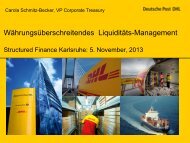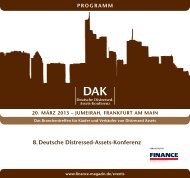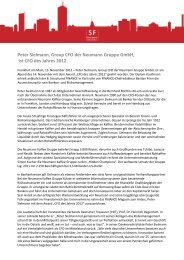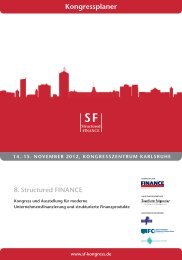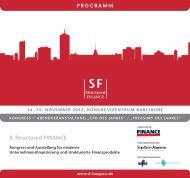The PERACS Alpha - Finance Magazin
The PERACS Alpha - Finance Magazin
The PERACS Alpha - Finance Magazin
You also want an ePaper? Increase the reach of your titles
YUMPU automatically turns print PDFs into web optimized ePapers that Google loves.
Neuvermessung einer Anlageklasse:<br />
Wie Rendite und Risiko bei<br />
Investments in verschiedene Private-<br />
Equity-Fonds korrelieren<br />
Prof. Oliver Gottschalg of HEC Paris<br />
Founder and Head of Research,<br />
<strong>PERACS</strong> Independent PE Track Record Analytics and Certification
Agenda<br />
• <strong>The</strong> Challenge<br />
• Combining unique data with advanced methods<br />
• Accurate Performance Measure: <strong>The</strong> <strong>PERACS</strong> <strong>Alpha</strong><br />
• Insightful Risk Metric: <strong>The</strong> <strong>PERACS</strong> Risk Curve and Coefficient<br />
• Empirical Evidence on the Risk and Return Relationship<br />
• Towards a Bottom-Up Risk Model for Private Equity<br />
2
Agenda<br />
• <strong>The</strong> Challenge<br />
• Combining unique data with advanced methods<br />
• Accurate Performance Measure: <strong>The</strong> <strong>PERACS</strong> <strong>Alpha</strong><br />
• Insightful Risk Metric: <strong>The</strong> <strong>PERACS</strong> Risk Curve & Coefficient<br />
• Empirical Evidence on the Risk and Return Relationship<br />
• Towards a Bottom-Up Risk Model for Private Equity<br />
3
Consideration of Risk in PE<br />
Typical Approach : Top Down based on aggregate times series data<br />
1 Use of listed PE Proxies (e.g. LPX50, as used for Solvency II/QIS Studies)<br />
Challenges:<br />
• Listed Private Equity vehicles not necessarily representative for typical unlisted PE, which<br />
leads to possible overstatement of volatility and correlation<br />
2<br />
Use of times series performance data from Private Equity Funds (e.g. Thomson One, preqin)<br />
Challenges :<br />
• Autocorrelation of performance data needs to be eliminated<br />
• Available databases consist largely of rather old funds (15+ years) for which NAVs were not<br />
systematically marked to market as they are today<br />
• Generally aggregate treatment of vintage years<br />
• No consideration of individual transactions and hence no specific treatment of different<br />
investment years, industry segments or deal sizes<br />
Existing Methods provide limited insights into risk-return relationship and are<br />
unsuitable to assess/compare riskiness of different fund managers and strategies<br />
4
Agenda<br />
• <strong>The</strong> Challenge<br />
• Combining unique data with advanced methods<br />
• Accurate Performance Measure: <strong>The</strong> <strong>PERACS</strong> <strong>Alpha</strong><br />
• Insightful Risk Metric: <strong>The</strong> <strong>PERACS</strong> Risk Curve & Coefficient<br />
• Empirical Evidence on the Risk and Return Relationship<br />
• Towards a Bottom-Up Risk Model for Private Equity<br />
5
Number of Variables<br />
<strong>The</strong> Data-Driven Approach<br />
of the HEC PE Observatory<br />
Number of Datapoints<br />
1<br />
Commercially Available Data<br />
(performance data on >5,000 PE funds<br />
with >100,000 underlying investments<br />
2<br />
3<br />
4<br />
Proprietary Survey&PPM data<br />
(>15,000 deals with deal IRR,<br />
target characteristics and<br />
investor information)<br />
Survey&PPM data<br />
(over 200 deals with detailed<br />
management & accounting<br />
information)<br />
Case<br />
Studies<br />
Access to unique data<br />
made possible through<br />
partnership with buyout<br />
firms, institutional<br />
investors, database<br />
vendors and industry<br />
associations during<br />
>10-year research effort.<br />
For more information, please visit www.buyoutresearch.org<br />
6
Agenda<br />
• <strong>The</strong> Challenge<br />
• Combining unique data with advanced methods<br />
• Accurate Performance Measure: <strong>The</strong> <strong>PERACS</strong> <strong>Alpha</strong><br />
• Insightful Risk Metric: <strong>The</strong> <strong>PERACS</strong> Risk Curve & Coefficient<br />
• Empirical Evidence on the Risk and Return Relationship<br />
• Towards a Bottom-Up Risk Model for Private Equity<br />
7
Measuring Returns:<br />
<strong>The</strong> « <strong>PERACS</strong> <strong>Alpha</strong> »<br />
Real-World Client Example<br />
KKR European Fund I (Vintage 1999)<br />
Duration =<br />
4.55 years<br />
2.85x<br />
2.15x 18.35%<br />
TVPI<br />
Variable-Rate<br />
Profitability Index<br />
<strong>PERACS</strong><br />
<strong>Alpha</strong><br />
Performance is measured in the excess of the cost of the forgone opportunity investing capital elsewhere, which is approximated by the MSCI World index,<br />
both in absolute multiple terms based on the <strong>PERACS</strong> Profitability Index and on an annualized basis through the <strong>PERACS</strong> <strong>Alpha</strong>, based on the duration of the<br />
investment.<br />
NAV at Par; Gross; All 41 Deals; Version 2.1.31; 11 Feb 2013, 4:00 PM; Page 13<br />
8
Measuring Returns:<br />
<strong>The</strong> « <strong>PERACS</strong> <strong>Alpha</strong> »<br />
Generic Example<br />
Linking <strong>PERACS</strong> <strong>Alpha</strong> to IRR<br />
36%<br />
Effect of IRR Bias due to<br />
reinvestment hypothesis<br />
26%<br />
18%<br />
8%<br />
A GP's "<strong>PERACS</strong> <strong>Alpha</strong>" is a<br />
measures of pure value<br />
generation that is corrected<br />
for the biases of standard<br />
IRR and expresses returns<br />
relative to the 'opportunity<br />
cost' of not investing in the<br />
public market. It is based on<br />
a refinement of the method<br />
developed by Acharya,<br />
Gottschalg et al. (Review of<br />
Financial Studies, 2012)<br />
GP IRR<br />
<strong>PERACS</strong><br />
Rate of<br />
Return<br />
<strong>PERACS</strong><br />
<strong>Alpha</strong><br />
Market<br />
Returns<br />
9
Focus: PE Performance<br />
during economic Cycles<br />
Three-Year Joint Research Effort with Golding Capital Partners<br />
10
Focus: PE Performance<br />
during economic Cycles<br />
• Deal-level analysis based on HEC/GCP research database: 4822 realized buyouts<br />
• Aggregate equity investment: 112.376.083.822,98 €<br />
• Representative Distribution across geographies, industries, size-categories<br />
• Inherent upward biases: data source ‘PPM’ ~ Top Quartile/Upper Half<br />
11 * Source: Research Project 2011 ‘Finding <strong>Alpha</strong>’ in Collaboration with Golding Capital Partners
Focus: PE Performance during the<br />
Great Financial Crisis<br />
<strong>Alpha</strong><br />
2.7%<br />
5,1%<br />
-2.4%<br />
Market <strong>Alpha</strong> Absolute<br />
<strong>Alpha</strong> M-IRR*<br />
Returns<br />
Rate of Return<br />
Vergleichbare<br />
Aktienrendite<br />
Commentary<br />
• This analysis is based on 345 crisisdeals,<br />
which were invested in before<br />
the collapse of Lehman‘s in<br />
September 2008 and realised post<br />
September 2008<br />
• <strong>The</strong> <strong>Alpha</strong> of these transactions is<br />
5.1% (gross of fees)<br />
• <strong>The</strong> absolute return of these<br />
transactions executiedin a difficult<br />
investment climate still continues to<br />
be positive on an average long-term<br />
basis<br />
Positive <strong>Alpha</strong> even on private equity deals<br />
which were directly affected by the crisis<br />
* Source: Research Project 2013 ‘Finding <strong>Alpha</strong>’ in Collaboration with Golding Capital Partners<br />
12
Agenda<br />
• <strong>The</strong> Challenge<br />
• Combining unique data with advanced methods<br />
• Accurate Performance Measure: <strong>The</strong> <strong>PERACS</strong> <strong>Alpha</strong><br />
• Insightful Risk Metric: <strong>The</strong> <strong>PERACS</strong> Risk Curve & Coefficient<br />
• Empirical Evidence on the Risk and Return Relationship<br />
• Towards a Bottom-Up Risk Model for Private Equity<br />
13
Cumulative Income Share<br />
Measuring Risk:<br />
<strong>The</strong> <strong>PERACS</strong> Risk Curve<br />
Inspired by Lorenz curve in Macroeconomics<br />
Approach used to assess Income Inequality across countries<br />
100<br />
80<br />
60<br />
40<br />
20<br />
0<br />
0 20 40 60 80 100<br />
Cumulative Population Share<br />
Brazil China Perfect<br />
Calculation and plotting of the<br />
aggregate performance (= <strong>Alpha</strong>)<br />
for any percentage of 'worst'<br />
deals in the portfolio. <strong>The</strong><br />
corresponding '<strong>PERACS</strong> Risk<br />
Curve' captures cumulative<br />
distribution function of the<br />
distribution of performance in a<br />
PE portfolio. Similar to the 'Gini<br />
Coefficient' for wealth<br />
distribution, we capture the<br />
distribution of performance in a<br />
single measure, the '<strong>PERACS</strong> Risk<br />
Coefficient', which makes it<br />
possible to compare and<br />
benchmark the risk of different<br />
PE portfolios in a measure that is<br />
independent of the performance<br />
of these portfolios.<br />
14
1<br />
5<br />
9<br />
13<br />
17<br />
21<br />
25<br />
29<br />
33<br />
37<br />
41<br />
45<br />
49<br />
53<br />
57<br />
61<br />
65<br />
69<br />
73<br />
77<br />
% of value creation<br />
<strong>The</strong> "<strong>PERACS</strong> Risk Curve"<br />
of a Typical PE Fund<br />
Generic Example<br />
100%<br />
80%<br />
60%<br />
40%<br />
20%<br />
0%<br />
-20%<br />
<strong>Alpha</strong> Drags<br />
Vertex<br />
<strong>Alpha</strong> Contributors<br />
Break Even<br />
Point<br />
Insight<br />
Overall assessment<br />
of the distribution<br />
(uniform vs. exponential)<br />
of returns<br />
in the portfolio as a<br />
new risk measure<br />
for PE portfolios.<br />
Benchmarking<br />
Comparison with<br />
average performance<br />
distribution<br />
from HEC PE<br />
database, based on<br />
different portfolio<br />
characteristics.<br />
Number of transactions<br />
15
Metric 5a – <strong>PERACS</strong><br />
Risk Curve by % of Deals<br />
Real-World<br />
Client Example<br />
Nordic Capital Fund V versus Fund VI<br />
<strong>PERACS</strong> Risk Coefficient<br />
100%<br />
80%<br />
60%<br />
40%<br />
20%<br />
0%<br />
-20%<br />
-40%<br />
Benchmark EU<br />
Since 2005 Large-Cap<br />
Nordic Capital Fund V<br />
Nordic Capital Fund VI<br />
0.90<br />
0.91<br />
0.59<br />
0.45<br />
-60%<br />
0% 20% 40% 60% 80% 100%<br />
0 0.5 1<br />
<strong>The</strong> <strong>PERACS</strong> Risk Curve illustrates the portion of the cumulative <strong>PERACS</strong> <strong>Alpha</strong> generated by the poorest-performing x% of the portfolio (as measured by %<br />
of deals). <strong>The</strong> <strong>PERACS</strong> Risk Coefficient expresses the skewedness of returns from 0 (perfectly uniform) to 1 (perfectly concentrated <strong>Alpha</strong>).<br />
16
Agenda<br />
• <strong>The</strong> Challenge<br />
• Combining unique data with advanced methods<br />
• Accurate Performance Measure: <strong>The</strong> <strong>PERACS</strong> <strong>Alpha</strong><br />
• Insightful Risk Metric: <strong>The</strong> <strong>PERACS</strong> Risk Curve & Coefficient<br />
• Empirical Evidence on the Risk and Return Relationship<br />
• Towards a Bottom-Up Risk Model for Private Equity<br />
17
Adjusted <strong>PERACS</strong> Risk Coefficient<br />
Negative (!) Link Between<br />
Risk and Return across GPs<br />
Across 152 PE GPs with >9 realized deals in Track record<br />
1.1<br />
1.0<br />
0.9<br />
0.8<br />
0.7<br />
0.6<br />
0.5<br />
R 2 Linear = 0,273<br />
0.4<br />
-0.1 0.0 0.1 0.2 0.3 0.4 0.5 0.6<br />
Aggregate <strong>Alpha</strong><br />
18
Adjusted <strong>PERACS</strong> Risk Coefficient<br />
Negative (!) Link Between<br />
Risk and Return across PE Funds<br />
Across 263 PE Funds with >9 realized deals<br />
1.1<br />
1.0<br />
0.9<br />
0.8<br />
0.7<br />
0.6<br />
0.5<br />
R 2 Linear = 0,193<br />
0.4<br />
-0.1 0.0 0.1 0.2 0.3 0.4 0.5 0.6<br />
Aggregate <strong>Alpha</strong><br />
19
Adjusted <strong>PERACS</strong> Risk Coefficient<br />
Negative (!) Link Between Risk and<br />
Return across Segments of the PE Universe<br />
Across 600 PE sectors (geography, industry, size, period)<br />
with >9 realized deals<br />
1.1<br />
1.0<br />
0.9<br />
0.8<br />
0.7<br />
0.6<br />
0.5<br />
R 2 Linear = 0,271<br />
0.4<br />
-0.1 0.0 0.1 0.2 0.3 0.4 0.5 0.6<br />
Aggregate <strong>Alpha</strong><br />
20
Agenda<br />
• <strong>The</strong> Challenge<br />
• Combining unique data with advanced methods<br />
• Accurate Performance Measure: <strong>The</strong> <strong>PERACS</strong> <strong>Alpha</strong><br />
• Insightful Risk Metric: <strong>The</strong> <strong>PERACS</strong> Risk Curve & Coefficient<br />
• Empirical Evidence on the Risk and Return Relationship<br />
• Towards a Bottom-Up Risk Model for Private Equity<br />
21
Consideration of Risk in PE<br />
Towards a Bottom-Up Risk Model for Private Equity<br />
• Monte Carlo simulation on an annual basis.<br />
• An company is purchased at a point in time (year 0) and is then either sold (exit case) or kept in the<br />
portfolio in the subsequent years.<br />
• NAV(n) denotes the current value of an individual investment in year n. We calculate NAV(n) on the<br />
basis of empirical data. In the Monte Carlo model, NAV(n) depends on the prior year figure, NAV(n-1).<br />
<strong>The</strong> distribution of ratio NAV(n)/NAV(n-1) varies depending on whether or not an exit takes place at<br />
time n.<br />
• In the event of an exit in year n, exit-NAV(n)/NAV(n-1) is assumed to be gamma distributed, with the<br />
parameters of this transitional distribution depending on the age and other characteristics (segment,<br />
etc.) of the investment and derived from empirical data.<br />
• In the event of no exit in year n, gamma distribution of NAV(n)/ NAV(n-1) is also assumed, with the<br />
parameters calculated in the same way as the exit case but generally resulting in different values<br />
(both the return and the standard deviation are usually higher in the case of exit than in the case of<br />
no exit).<br />
Existing Methods provide limited insights into risk-return relationship and are<br />
unsuitable to assess/compare riskiness of different fund managers and strategies<br />
22
Towards a Bottom-Up Risk<br />
Model for Private Equity<br />
…<br />
NAV(3)<br />
NAV(2)<br />
…<br />
NAV(1)<br />
Exit-NAV(3)<br />
NAV(0)<br />
Exit-NAV(2)<br />
Exit-NAV(1)<br />
Jahr 0 Jahr 1 Jahr 2 Jahr 3 Jahr 4<br />
YEAR EXIT PROBABILITY EXIT MULTIPLE<br />
1 3.9% 1.45<br />
2 5.6% 2.02<br />
3 12.0% 2.43<br />
4 13.1% 2.72<br />
5 13.3% 2.53<br />
6 10.5% 2.34<br />
7 10.1% 2.21<br />
8 9.9% 2.32<br />
9 6.2% 2.00<br />
10 4.8% 1.98<br />
11 3.5% 2.08<br />
* Source: joint Research Project with Dr. Bernd Kreuter, Palladio Partners
J-curve effect in the early investment phase<br />
High returns and moderate risk in years 3 to 6<br />
Moderate returns and high risk from year 7 onwards<br />
Invested capital (as % of fund commitment), performance<br />
and value at risk of an average individual fund<br />
70%<br />
60%<br />
50%<br />
40%<br />
30%<br />
20%<br />
10%<br />
0%<br />
-10%<br />
1 2 3 4 5 6 7 8 9 10 11 12 13<br />
-20%<br />
-30%<br />
-40%<br />
-50%<br />
* Source: joint Research Project with Dr. Bernd Kreuter, Palladio Partners<br />
Investiertes Kapital Erwartete Jahresrendite (realisiert und unrealsiert) 99,5% VaR bei gut diversifiziertem Fonds 99,5% VaR bei weniger gut diversifiziertem Fonds
Invested capital (as % of total commitment),<br />
performance and value at risk of a portfolio<br />
50%<br />
40%<br />
30%<br />
20%<br />
10%<br />
0%<br />
-10%<br />
1 2 3 4 5 6 7 8 9 10 11 12 13<br />
-20%<br />
-30%<br />
-40%<br />
Investiertes Kapital<br />
Erwartete Jahresrendite (realisiert und unrealsiert)<br />
99,5% VaR bei gut diversifiziertem Fonds 99,5% VaR bei weniger gut diversifiziertem Fonds<br />
* Source: joint Research Project with Dr. Bernd Kreuter, Palladio Partners
Summary and Conclusions<br />
• <strong>The</strong> <strong>PERACS</strong> <strong>Alpha</strong> accurately measures what LP (should) care about:<br />
annualized returns relative to the “opportunity cost” of PE investing<br />
• <strong>Alpha</strong> has been found to be concentrated in difficult economic times<br />
• Based on 345 realized PE deals around the Great Financial Crisis, we still<br />
document a positive <strong>Alpha</strong> of over 500 Basis Points<br />
• <strong>The</strong> <strong>PERACS</strong> Risk Curve/Coefficients traces relevant aspects of PE Risk in an<br />
intuitive fashion<br />
• Risk and Return in PE seem to be negatively correlated: Better GPs deliver<br />
greater <strong>Alpha</strong> at lower volatility<br />
• Bottom-up Risk Modeling for PE Portfolio makes more accurate risk<br />
budgeting possible<br />
26
Thank you for your attention !<br />
27
About Professor Oliver Gottschalg<br />
Current Positions<br />
• Director of the HEC PE Observatory<br />
• Academic Director of the TRIUM<br />
Global Executive MBA Program<br />
• Founder and Head of Research,<br />
Peracs, PE Track Record Analytics<br />
Research<br />
• Published in the Review of Financial Studies, Harvard Business<br />
Review, Academy of Management Review, Strategic<br />
Management Journal, Journal of Banking and <strong>Finance</strong>, etc.<br />
• Featured over 100 times in the business media (press, radio,<br />
TV and online) in the past 2 years, including <strong>The</strong> Economist,<br />
Financial Times, Wall Street Journal, Financial News, Les Echos,<br />
etc.<br />
Consulting<br />
• Tailored projects for leading sponsors, institutional investors<br />
and advisors. Repeatedly served as advisor to policy makers at<br />
the national and European level in questions related to the<br />
possible regulation of private equity.<br />
Education<br />
• Dipl. Wirtschaftsingenieur (TU Karlsruhe)<br />
• MBA (Georgia State University)<br />
• MSc. of Management (INSEAD)<br />
• Ph.D. (INSEAD)<br />
Work Experience<br />
• Federal Reserve Bank, US<br />
• Bain & Company – Private Equity Practice<br />
Teaching<br />
• HEC MBA Program<br />
• HEC Grande Ecole Program<br />
• HEC Executive Education<br />
• TRIUM Global EMBA Program<br />
• INSEAD Executive Education<br />
• LBS Executive Education<br />
• Tsinghua University Executive Education<br />
• Company-Specific Executive Programs<br />
28
About <strong>PERACS</strong><br />
• <strong>PERACS</strong> is not just another performance benchmark, but it provides<br />
customized and insightful metrics to quantify relevant elements of past<br />
performance, risk attributes and strategic differentiators<br />
• Independent, credible, trustworthy, global, conflict-free, and singularly<br />
focused<br />
• Granular analysis built up from company by company portfolio analysis<br />
• Formulaic and transparent. Trusted standardized comparisons<br />
• Dynamic quarterly updates and annual reviews<br />
• Methodology of leading industry academics and investors<br />
• Value added service provided by GPs to their LPs<br />
• Used in GP marketing materials with success<br />
<strong>PERACS</strong>: <strong>The</strong> Global Standard for PE Performance Analytics<br />
29
Five <strong>PERACS</strong> Metrics<br />
A<br />
B<br />
C<br />
D<br />
E<br />
Measuring Returns based on the <strong>PERACS</strong> <strong>Alpha</strong> and the <strong>PERACS</strong> Rate of Return<br />
• Enhanced Performance Measurement, avoiding issues with IRR Methodology<br />
• Public-Market Benchmarking (PME) Perspective<br />
• Quantification of different components of GP's added value<br />
Benchmarking Returns<br />
• Objective and data-driven identification of 'Relevant Peer Funds'<br />
Documenting Value Creation Components based on <strong>PERACS</strong> Value Driver Bridge<br />
• Growth, efficiency gains, multiple expansion, debt reduction, currency fluctuation<br />
Strategic Distinctiveness<br />
• Measures of distinctive strategy, unique deal flow, and strategic consistency/drift<br />
Measuring Return Volatility based on the <strong>PERACS</strong> Risk Curve and Coefficient<br />
• Assessment of portfolio risk based on historical return distribution<br />
• Graphical representation based on intuitive curve inspired by "Lorenz Curve"<br />
Detailed video tutorials in all <strong>PERACS</strong> methods are available on<br />
Youtube and on <strong>PERACS</strong>.com<br />
30
<strong>PERACS</strong> in the ILPA Newsletter<br />
31



